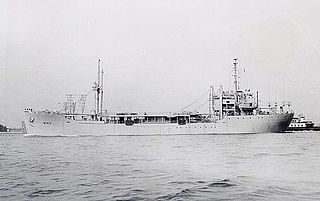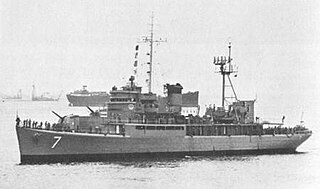
The USCGC Courier (WAGR/WTR-410) was a cutter in the United States Coast Guard converted from the M/V Coastal Messenger a Maritime Commission Type C1-M-AV1 vessel.

A Coast Guard Air Station provides aviation support for the United States Coast Guard. The Coast Guard operates approximately 210 aircraft from 24 Coast Guard Air Stations in the United States. Fixed-wing aircraft, such as the HC-130 Hercules, are built for long range missions and operate from air stations. The air stations and facilities are also home to locally based MH-65D Dolphin and Sikorsky HH-60 Jayhawk helicopters and support rotor craft assigned to flight deck equipped cutters.
This article covers the organization of the United States Coast Guard.
USS Barricade (ACM-3) was a Chimo-class minelayer in the United States Navy during World War II.

USS Barbican (ACM-5) was a Chimo-class minelayer in the United States Navy. Barbican was later commissioned in U.S. Coast Guard as USCGC Ivy.

United States Naval Districts is a system created by the United States Navy to organize military facilities, numbered sequentially by geographic region, for the operational and administrative control of naval bases and shore commands in the United States and around the world. Established in 1903, naval districts became the foundational system for organizing U.S. naval forces ashore during the 20th century. The term "Naval" forces includes United States Marine Corps and current United States Coast Guard units.

USS Biscayne (AVP-11), later AGC-18, was a United States Navy Barnegat-class seaplane tender in commission as a seaplane tender from 1941 to 1943 and as an amphibious force flagship from 1943 to 1946. She saw service during World War II. Transferred to the United States Coast Guard after the war, she was in commission as the Coast Guard cutter USCGC Dexter (WAGC-385), later WAVP-385 and WHEC-385, from 1946 to 1952 and from 1958 to 1968.

USS Bering Strait (AVP-34) was a United States Navy Barnegat-class small seaplane tender in commission from 1944 to 1946. She tended seaplanes during World War II in the Pacific in combat areas and earned three battle stars by war's end.

USS Coos Bay (AVP-25) was a United States Navy Barnegat-class small seaplane tender in commission from 1943 to 1946 that saw service during the latter half of World War II. After the war, she was in commission in the United States Coast Guard from 1949 to 1966 as the cutter USCGC Coos Bay (WAVP-376), later WHEC-376.

USS Cook Inlet (AVP-36) was a United States Navy Barnegat-class small seaplane tender in commission from 1944 to 1946. She tended seaplanes during World War II in the Pacific and earned one battle star for her service. After the war, she was transferred to the United States Coast Guard, and was in commission as the Coast Guard cutter USCGC Cook Inlet (WAVP-384), later WHEC-384, from 1949 to 1971. She saw service in the Vietnam War during her Coast Guard career, receiving two campaign stars for her operations during the conflict. Transferred to South Vietnam in 1971, she operated as the Republic of Vietnam Navy frigate RVNS Trần Quốc Toản (HQ-06) until South Vietnam's collapse in April 1975 at the end of the Vietnam War. She fled to the Philippines and in 1976 was transferred to the Philippine Navy, which never commissioned her, instead using her as a source of spare parts for her sister ships, the Andrés Bonifacio-class frigates, before discarding her in 1982.

BRP Andrés Bonifacio (PF-7) was a Philippine Navy frigate in commission from 1976 to 1985. She was one of six ex-United States Navy Barnegat-class small seaplane tenders/ex-United States Coast Guard Casco-class high endurance cutters received from the United States after the Vietnam War, two of which were acquired to supply spare parts for the other four. Andrés Bonifacio was considered the lead ship of her class in the Philippine Navy, and she and her three commissioned sister ships were the largest Philippine Navy combat ships of their time.
BRP Diego Silang (PF-9) was an Andrés Bonifacio-class frigate of the Philippine Navy in commission from 1976 to 1990. She and her three sister ships were the largest Philippine Navy ships of their time.

USS Rockaway (AVP-29), later AG-123, was a United States Navy Barnegat-class seaplane tender in commission from 1943 to 1946. She served in both the Atlantic Ocean and the Pacific Ocean during World War II. In 1948, she was loaned to the United States Coast Guard, in which she served as the cutter USCGC Rockaway (WAVP-377), later WAGO-377, WHEC-377, and WOLE-377, from 1949 to 1972.

USCGC Elm (WLB-204) is a U.S. Coast Guard Juniper-class seagoing buoy tender home-ported in Astoria, Oregon. She is responsible for maintaining aids to navigation on the coasts of Oregon and Washington, including the Columbia River.
USCGC Tupelo WAGL/WLB-303, was a Cactus (A) Class 180-foot buoy tender vessel built by Zenith Dredge Company of Duluth, Minnesota. Her keel was laid 15 August 1942, launched 28 November 1942 and commissioned on 30 August 1943. She was built as a WAGL and redesignated a WLB in 1965.

District 13 is a United States Coast Guard district, based at the Henry M. Jackson Federal Building, in Seattle, Washington. It covers the Pacific Northwest and its Area of Responsibility encompasses four states; Washington, Oregon, Idaho, and Montana. District 13 is divided into three Sectors – Puget Sound, Columbia River and North Bend. The District has more than 3,000 active duty and reserve members, civilian employees, and auxiliaries and operates twenty-one cutters, 132 boats and eleven aircraft.

USS YF-339 was an American YF-257-class covered lighter built in 1944 for service in World War II. She was later acquired by the United States Coast Guard and renamed USCGC White Bush (WAGL-542).

Astoria Marine Construction (AMCCO) was founded as Astoria Shipbuilding by Joe Dyer is 1929 in Jeffers Gardens of Astoria, Oregon. Joe Dyer's father was a pioneer of early Astoria and operated a family sawmill. Joe Dyer started by building wooden fishing boats at his shipyard. Then added wooden pleasure craft to his product line. Joe Dyer designed and built Columbia River One Design (CROD) boats and boats for the United States Navy. The shipyard was on the east bank of the Lewis and Clark River and the Jeffers Slough. Due to its historical importance the site is on the National Register of Historic Places in Clatsop County, Oregon. Astoria Marine Construction shipyard closed in 2013.















